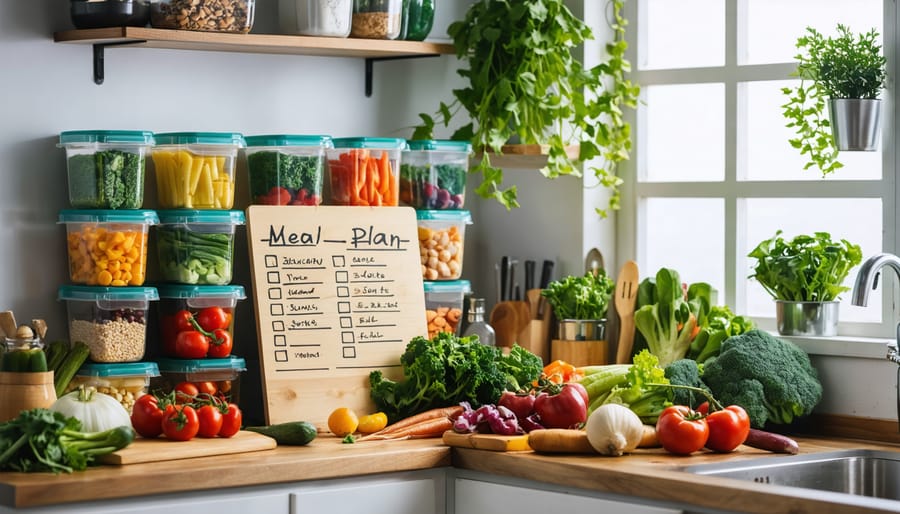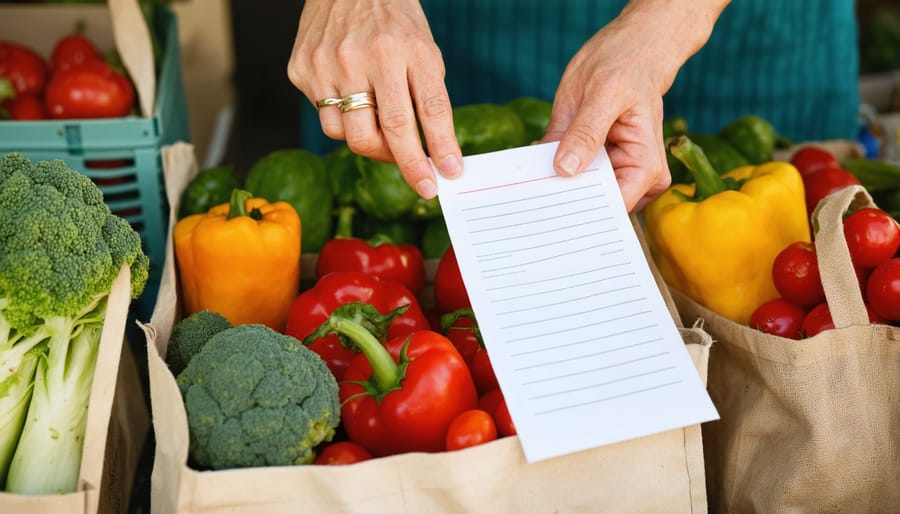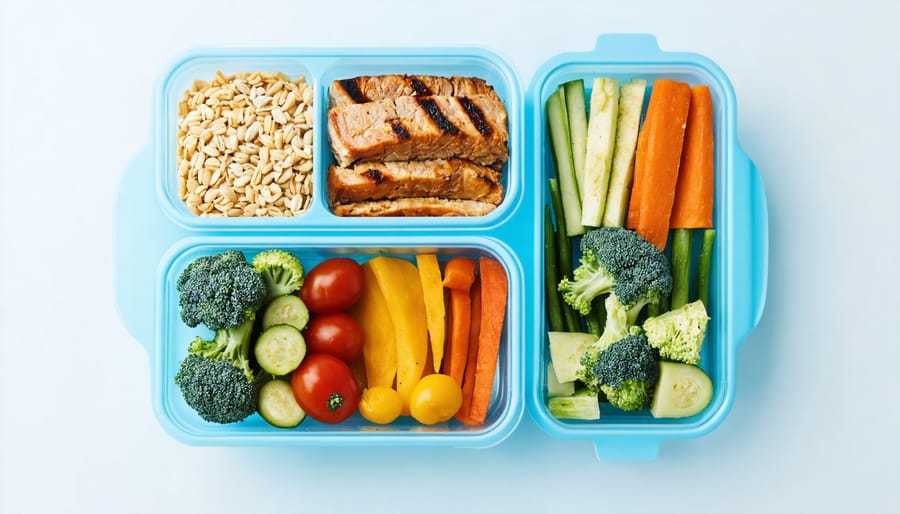
Transform your relationship with food and your budget through mindful eating practices that make every dollar and every bite count. Imagine sitting down to a thoughtfully prepared meal, savoring each flavor while knowing you’ve stayed within your budget – this isn’t just a dream, it’s a practical reality waiting to unfold in your kitchen.
By combining intentional meal planning with mindful consumption, you’re about to discover how to nourish both your body and your bank account. Whether you’re a busy professional looking to streamline your weekly meal prep or someone seeking a deeper connection with their food choices, this mindful eating plan offers a fresh perspective on sustainable, budget-conscious nutrition.
Gone are the days of rushed meals and impulsive grocery purchases. Instead, we’ll explore a balanced approach that honors both your financial goals and your desire for meaningful food experiences. This guide will show you how to transform everyday meals into moments of mindful connection, all while keeping your grocery budget in check.
Let’s create a practical, sustainable approach to eating that serves both your wallet and your wellbeing.
The Mindful Shopping Experience
Creating Your Conscious Shopping List
Creating a mindful shopping list isn’t just about jotting down items – it’s about intentionally planning meals that nourish both body and soul while respecting your budget. I’ve found that taking 15 minutes to plan before heading to the store can transform your entire shopping experience.
Start by doing a quick inventory of your pantry and fridge. This simple step has saved me countless dollars by preventing duplicate purchases and reducing food waste. Next, plan your meals for the week, considering your schedule and energy levels on different days. Remember, being realistic about your cooking time is key to sticking to your plan!
When building your list, organize items by store section – produce, proteins, grains, etc. This natural flow makes shopping more efficient and less overwhelming. I like to include a mix of versatile ingredients that can work in multiple recipes, like quinoa or sweet potatoes.
Consider seasonal produce, which is often more affordable and at peak freshness. Leave a little flexibility in your list for unexpected finds or substitutions – sometimes the best mindful choices happen when we’re open to alternatives. Finally, add quantities next to each item to avoid overbuying and stay within your budget while ensuring you have exactly what you need for your planned meals.

Seasonal Smart Shopping
Shopping with the seasons isn’t just a trendy catchphrase – it’s a smart strategy for both your wallet and your well-being. When you embrace seasonal produce shopping, you’re tapping into nature’s rhythm while scoring the best deals on the freshest foods.
I’ve discovered that summer tomatoes and berries often cost half of what they do in winter, and they taste infinitely better too! Create a seasonal calendar for your area and plan your meals around what’s naturally abundant. For instance, load up on root vegetables and squashes in fall, citrus fruits in winter, and fresh greens in spring.
Local farmers’ markets are goldmines for seasonal bargains, especially during peak harvest times. Pro tip: Visit just before closing time – vendors often offer better deals to clear their stock. Remember to batch buy when prices are low and learn simple preservation methods like freezing or canning.
Don’t forget to check your local grocery store’s seasonal specials. Many stores offer significant discounts on produce during peak seasons. By aligning your shopping with nature’s calendar, you’ll enjoy superior taste and nutrition while keeping your grocery budget in check.
Mindful Meal Planning Basics
Portion Planning with Purpose
Mastering portion control doesn’t mean you need to break out a food scale at every meal. Instead, think of portion planning as a mindful practice that helps you honor both your body’s needs and your budget. I learned this lesson the hard way after throwing away countless containers of forgotten leftovers!
Start by establishing an efficient meal prep routine that includes portioning your meals right after shopping. Use visual cues rather than strict measurements – your palm for protein portions, your cupped hand for carbohydrates, and your thumb for fats. This intuitive approach makes portion control feel more natural and less restrictive.
To minimize food waste, try the “cook once, eat twice” method. When preparing dinner, make enough for lunch the next day, but resist the urge to cook in bulk unless you’re certain you’ll eat it all. Store portions in clear containers at eye level in your fridge – what you see is what you’ll eat!
Consider investing in portion-controlled containers that make it easy to pack just the right amount. And remember, it’s okay to adjust portions based on your hunger levels – mindful eating means listening to your body while being conscious of waste. Start small; you can always go back for seconds if you’re truly hungry.

Balanced Meal Building
Creating balanced meals doesn’t have to break the bank – I’ve learned this through years of mindful meal planning. Start by dividing your plate into three sections: half for colorful vegetables, a quarter for lean proteins, and a quarter for whole grains or complex carbohydrates. This simple visual guide helps maintain portion control while ensuring you get all the nutrients you need.
When shopping on a budget, focus on seasonal produce, which is typically more affordable and at peak nutrition. I love visiting local farmers’ markets in the late afternoon when vendors often offer better deals. Frozen vegetables are another budget-friendly option that’s just as nutritious as fresh ones.
For proteins, consider incorporating more plant-based options like lentils, beans, and chickpeas. They’re not only cost-effective but also packed with fiber and nutrients. When buying meat, look for sales and freeze portions for later use. Eggs are another versatile and affordable protein source that can work in any meal of the day.
Whole grains like brown rice, quinoa, and oats can be bought in bulk to save money. They’re filling, nutritious, and can be prepared in advance for quick meal assembly. Remember to include healthy fats through affordable options like seeds, nuts, or avocados – a little goes a long way!
The key is planning ahead and being flexible with ingredients while maintaining the basic principles of a balanced plate.
The Art of Mindful Preparation
Prep Day Rituals
Transform your meal prep into a mindful ritual by creating a peaceful atmosphere that nurtures both body and soul. I’ve found that setting aside Sunday afternoons for meal preparation has become one of my favorite weekly traditions, and I’d love to share how you can make it special too.
Start by decluttering your kitchen space and wiping down all surfaces. Put on some calming music – I personally love instrumental jazz or nature sounds – and light a subtle scented candle. Take a few deep breaths and set your intention for the week ahead.
Lay out all your ingredients on the counter, taking a moment to appreciate the colors, textures, and freshness of your foods. This visual reminder of nature’s abundance helps ground you in gratitude. Keep a glass of water or herbal tea nearby to stay hydrated while you work.
Create stations for different tasks: one for washing and chopping vegetables, another for portioning proteins, and a third for assembling containers. This organization helps maintain a steady, peaceful flow as you move through your prep work.
Take your time with each task, paying attention to the sounds, smells, and sensations. Notice the crisp sound of cutting fresh vegetables, the aromatic herbs, and the satisfying feeling of filling containers with nourishing meals.
Remember, this isn’t just about preparing food – it’s about creating a weekly ritual that connects you more deeply with your nutrition while setting a positive tone for the week ahead.
Storage Solutions
Let me share a game-changing realization I had during my mindful eating journey: proper food storage isn’t just about keeping things fresh – it’s about respecting our food and reducing waste, which naturally aligns with mindful eating principles.
Start by conducting a weekly fridge audit before grocery shopping. This simple practice helps you stay aware of what you have and prevents duplicate purchases. Invest in clear, airtight containers that allow you to see your ingredients at a glance. I love using mason jars for storing nuts, seeds, and grains – they keep everything fresh and create an aesthetically pleasing pantry that makes meal prep more enjoyable.
For fresh produce, remember the ethylene rule: some fruits and vegetables release ethylene gas, which can speed up ripening in other produce. Store apples, bananas, and avocados separately from ethylene-sensitive items like leafy greens and berries. Use produce storage bags or containers with built-in ventilation to extend shelf life.
Label everything with purchase dates and expected expiration times. This mindful practice helps you use ingredients before they spoil and maintains a organized system. Store herbs in water-filled jars with loose plastic bags over the top – they’ll stay fresh longer and add a touch of green to your kitchen.
For prepared meals, use portion-sized containers and arrange them in your fridge with the earliest expiration dates in front. This FIFO (First In, First Out) method ensures nothing gets forgotten in the back of your fridge, reducing food waste and keeping your mindful eating plan on track.
Mindful Eating Practices

Creating Sacred Meal Times
Transform your dining space into a sanctuary by creating intentional meal times that nourish both body and soul. Start by designating a specific eating area – even if it’s just a corner of your kitchen table – and keep it clutter-free. I learned this simple trick from my grandmother, who always insisted on using a proper tablecloth, even for everyday meals.
Set the mood by dimming harsh overhead lights and using softer lighting options. Consider playing gentle background music, or embrace the peaceful silence. Put your phone on silent and store it away from the table – those notifications can wait!
Before each meal, take three deep breaths to center yourself. This small ritual helps transition from the busy day to a more present state of mind. Use real plates and utensils whenever possible, as they enhance the dining experience and encourage you to eat more mindfully.
Remember, creating sacred meal times isn’t about perfection – it’s about bringing intention to your eating experience. Even if you only have 15 minutes for lunch, you can make it special by setting a proper place and focusing solely on your meal.
Staying Present with Your Food
Picture this: you’re enjoying a delicious meal, but your mind is racing through tomorrow’s to-do list. Sound familiar? Staying present during meals is a skill that transforms not just how we eat, but how we experience food altogether.
Start by creating a peaceful eating environment – turn off the TV, put your phone away, and if possible, sit at a proper table. Take a moment to observe your food’s colors, textures, and aromas before taking your first bite. As you eat, try to identify different flavors and notice how they combine and evolve.
Pay attention to your body’s signals. Are you eating at a comfortable pace? How does your hunger level change throughout the meal? Take smaller bites and put your utensils down between them. This simple practice helps you slow down naturally.
Remember, mindful eating isn’t about perfect focus – it’s about gentle awareness. When your mind wanders (and it will!), simply guide your attention back to your meal without judgment. With practice, these moments of presence become more natural and rewarding.
Embracing mindful eating doesn’t mean breaking the bank – in fact, it can help you make smarter financial choices while nurturing a healthier relationship with food. By being present during meal planning, shopping, and eating, you’ll naturally gravitate toward more conscious spending habits and waste less food. I’ve personally found that when I slow down and really consider my food choices, I make better decisions for both my body and my budget.
Remember, this journey is about progress, not perfection. Start small by implementing one or two mindful practices at a time, whether it’s keeping a gratitude food journal or planning your meals with intention. As these habits become second nature, you’ll discover that mindful eating isn’t just another diet – it’s a sustainable lifestyle that benefits your wellbeing, your wallet, and the world around you. Here’s to taking the first step toward a more mindful and budget-conscious relationship with food!



